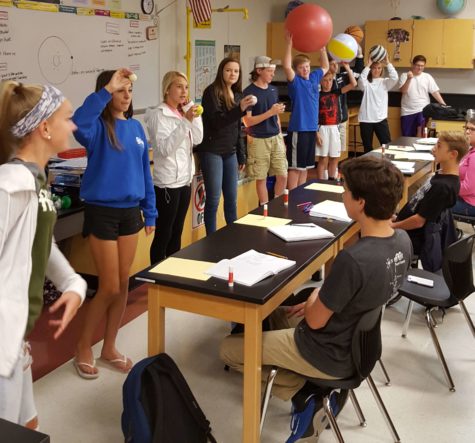Class of 2020 experiments with new Physics of Earth and Space class
Andrew Martin (left) and Johan Samayoa (right) study the Earth together in Mrs. McCauley’s fourth period PES class.
September 29, 2016
The science class Physics of Earth and Space is new to Linganore 2016-2017 and was created by teachers in response to the Next Generation Science Standards. It was formed in order for students to be able to explore and comprehend the earth and space realms of science.
What is it?
Physics of Earth and Space (PES) is a new foundational ninth grade course. Essentially, this class was created based on the Next Generation Science Standards (NGSS), which gave a push across the entire country to make sure that all science programs match the needs of the country’s science work force. NGSS wanted to make sure that every student left high school with knowledge in the categories of life science, physical science, and earth science.
In Frederick County, there was not a class that met these standards–which led to the birth of the PES class.
“It’s kind of like the applications of physics through an earth science course,” said PES teacher Mrs. Amber McCauley.
For example, instead of learning just what an ocean wave is, students will learn how and why an ocean wave happens and what it does.
Freshmen now must either take PES or Algebra-Based Physics. They took either Biology or Introduction to Chemistry and Physics (ICP) before 2016-2017.
What do you learn?
Physics of Earth and Space science combines both physical science and earth and space science concepts. It will teach a lot of everything–chemistry, biology, astronomy, and some engineering.
Lauren Miller, Class of 2020, said that she simply loves the class and everything to do with it.
Specifically, she loves the experiments she and her class perform. She said that she did an experiment where students wear 3-D glasses and look at neon lights in the dark. This is an exercise used to help students understand the stars’ brightness and heat. Miller said, “It’s just very interesting” and that she cannot wait to learn more about the stars and space.
Miller also said that she feels that this class builds on what students would have learned in their previous years of science. It reviews what they know and moves forward from there.
Instead of taking the new PES class, students may take Algebra-Based Physics, which is also new this year. The only difference between these two classes is that the Algebra-Based Physics is more math oriented, which means a student who connects better with math should take this course. Algebra-Based Physics also works as a prerequisite to AP Physics.
PES vs. Biology
“I want all our science classes to be challenging, rigorous, and for students to have to ponder and investigate science,” said Ms. Colleen Beall, Science Coordinator for Secondary Schools at FCPS.
However, this class might be considered “harder” than Biology simply because it is so new and many teachers are still adjusting their teaching methods to the new curriculum.
McCauley described PES as “less rigid.” She is especially enthusiastic that PES is more authentic because it encompasses and pertains to more areas of science rather than biology.
Students take their science classes in the current order (PES, Biology, Chemistry) because of a new test being created called Maryland Integrated Science Assessment (MISA) that will cover all three subjects. This test will replace the Biology HSA and will be phased in over time as a graduation requirement. It is still under development, but the Class of 202o will take a version of the cumulative exam.
A positive direction
PES was piloted at Oakdale and Thomas Johnson High Schools, where they held a survey on how the class was received.
“What students really liked about it was the real-life aspect. What they didn’t like? Notes,” Beall said.
The class has been given a good review from the teachers. McCauley loves PES. “It’s a lot to prepare because I’ve never taught it before, but I really love it because the students do and they’re really good at it.”
Change comes from the University
Science reform started from college and worked its way down the school system. Universities fought for PES because they needed students to be able to do inquiry.
Now that PES has begun, there is a spiraling curriculum rather than cut up in different blocks of knowledge.
PES also opens up the opportunity for students to take various other science elective courses as upperclassmen. For example, PES will open up the doors to “Climate, Ocean, Weather Science,” which is almost like an AP PES. This class is being piloted at Thomas Johnson and Brunswick High School.

Mrs. McCauley’s fourth period class does a scale comparison of the planets using various sized balls.



